On this page:
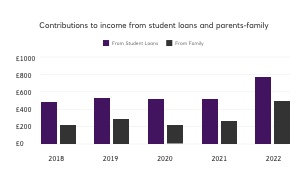
Student loans provide largest income boost
Perhaps unsurprisingly, student loans have remained the top source of income for university goers over the last five years. Student loans gave them an average monthly income of £443.40 back in 2018. This fluctuated in the years that followed, before peaking at £714 in 2022.
Away from necessities like food, household bills and travel, socialising remains Parents and other family members are the next largest source of student income. On average, they typically contribute around half as much as student loans. Their monthly contribution stood at £199.70 during 2018 but had surged to £434 by 2022.
We’ll have to wait until next year’s survey to see whether the large 2022 increases in student loans and family contributions mark the start of a new trend. But the lingering effects of the pandemic may explain the rise for means-tested student loans. And it’s possible the growing pressure of inflation might be fuelling higher parental contributions.
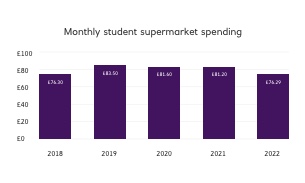
Grocery shopping continues to dominate monthly spending
Supermarket shopping has consistently taken up the largest share of students’ income since 2018, after their monthly rental costs. Monthly spending on groceries has ranged from around £76 to £83.50 since our survey began. It’s currently at a similar level to where it was back in 2018 (at £76.29 now compared to £76.30).
The peak, of £83.50 recorded in 2019, was more than double students’ spending on the next biggest outgoing. Spending on groceries remained high in 2020 and 2021 (at £81.60 and £81.20 respectively). This may reflect students spending more time at home or in rented accommodation amid the pandemic, with the figure then dropping back in 2022.
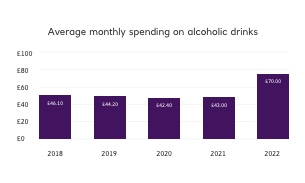
End of lockdown puts fizz back into alcohol spending
Our 2022 survey marked the end of a slowdown in average alcohol spending, with the removal of Covid restrictions potentially having an impact. Students typically spent just over £41 a month on alcohol in 2018. This slipped 34% in the following year to an average of £27.20. The figure remained relatively low in both 2020 and 2021 (at £29.30 and £27.10 respectively). This trend might be explained by members of Generation Z appearing to show less interest in alcoholic drinks.
The return of socialising and a sense of post-Covid normality kickstarted spending in 2022, however. Monthly spending leaped 37% to £43.30. Our 2023 index will give a much stronger indication of whether there has been a meaningful shift back towards alcohol.
On a regional basis, Liverpool’s students are now spending £30.50 more on alcohol than the UK average each month. At the other end of the scale, Cambridge students are currently spending the least (£16.60 a month).
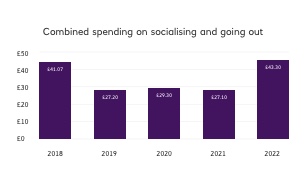
Socialising makes post-Covid comeback
Away from necessities like food, household bills and travel, socialising remains the largest area of spending for UK students. Students’ spending almost doubled from 2021 to 2022, with the easing of pandemic restrictions likely to be a key factor. In 2022, spending on going out and socialising with friends reached an average of £70 a month. Newcastle, Liverpool, Canterbury, Leeds and Manchester were top when it came specifically to going out, with London sixth but still above the average. Students in Southampton spent the least on going out, at £14.70.
During 2021, with partial Covid restrictions still in place, the sum spent on going out and socialising was significantly lower (under £43). When it came to going out in 2021, Manchester, Oxford, Newcastle and Liverpool students topped the chart, with York at the bottom.
Combined spending on socialising and going out was also much lower than the 2022 total during 2018 (£46.10), 2019 (£44.20) and 2020 (£42.40).
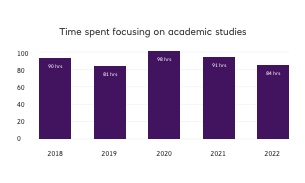
Academic study stays top of the activity chart
One thing remains consistent for students despite the ups and downs of the past five years: time spent on academic study. This has consistently been their most time-consuming activity since 2018. Studying time spiked in 2020 at the height of the pandemic, hitting a monthly average of 98 hours. By 2022, this had eased closer to the norm, at 84.42 hours. Students at red brick universities generally dedicate the most hours to studying.
Our latest survey points to a return to in-person campus teaching. Yet the impact of social distancing and home-based study is still being felt. Some 45% of study time was spent at home in 2020, climbing to 70% in the following year. But by 2022, 63% of student’s time was spent back on campus.
We could help you manage your finances
We understand how the current circumstances can add pressure on student budgets. Visit our support hub for students to find out what financial support is available to you.
Download the Student Living Index
Are you currently attending university or still deciding where to go? Read our 2022 Student Living Index in full to discover which students are spending the most on rent, who the most sociable are, and much more.
Need a student bank account?
Our Student bank account comes with:
- A four-year tastecard. Offer T&Cs apply
- Up to £2,000 Interest-free arranged overdraft from year one (limited to £500 in your first term).
- You can apply for up to £3,250 interest free from year three onwards.
Overdraft subject to eligibility. 18+.
Apply online only. You must be 17+ and have been living in the UK for at least 3 years.
Study details: You need to be full time undergraduate student (on at least a 2 year course at a UK University/College) or you need to be completing a full time postgraduate or nursing course lasting a year or more. You can apply within 6 months of your course start date.
Overdraft details: You need to be 18+ to apply for an overdraft. You can add an overdraft to your account once your course has started.

